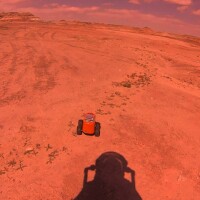Our Journey to Building a Life on Mars


Relive the excitement of man’s first steps on the moon and the long journey it took to get there with 20 new hours of out of this world programming on KCET's “Summer of Space" Watch out for “American Experience: Chasing the Moon” and a KCET-exclusive first look at "Blue Sky Metropolis," four one-hour episodes that examine Southern California’s role in the history of aviation and aerospace.
Humans will likely become a planet-wandering people, but what sort of life will they lead on other worlds? Mars City Design asks architects, designers and engineers alike to dream up the future of Mars: Not one that is beyond reach, but possible in the future.
The project is the brainchild of Vera Mulyani, who founded the collaborative platform to explore the concept of livability and sustainability on Mars as well as Earth. She has been called a “Marschitect.” The organization holds design challenges and workshops in different cities each year, and they’ve been happening since 2015. Students and space enthusiasts across the globe put their out-of-this-world ideas to the test.
“At the moment, we prioritize the science and transportation to get to Mars,” Mulyani says. “I also really wish we’d start to care about the destination and what life will be like when we get there. That’s the heart of the project.” For the last five years, Mars City Design has held competitions and workshops to test and analyze the best ideas. Participants come from a variety of backgrounds, from art and design to aerospace engineering to social sciences.
Dean Little was one of the competition’s winners in 2016. Growing up, he wanted to be an astronaut. “But as an Australian, we don’t really have a space agency,” he says. “I decided to go into tech instead.” But after he watched the rise of Elon Musk, he joined a Mars online group, where he saw a post by Mulyani.
Little submitted a project about a Mars clock: an app that lets the user set alarms for any time zone on Mars. Just like the clock app on your smartphone, the Mars clock lets someone set a stopwatch or a countdown timer. The problem, as Little puts it, is that when we go to Mars, how will we know what time to wake up? One day on Mars is a bit longer than an Earth day. “If you peg your clock to Earth time, it slips out of sync by 37 minutes a day,” he says. And that has implications: if a Mars explorer is out working and is not back before sunset, every minute out there increases the chances of dying substantially.
So tying time into mission planning is important, Little says. If the sun sets at 6 p.m. local Mars time, explorers will want to calculate how far they are from the habitation in miles per hour. “A lot of people haven’t given it much thought, but if you went to Mars as a tourist, you could literally just use the Mars Clock app like your regular alarm clock app,” he says.
The competition also boosted Little’s dreams of working in the world of space: he was able to bootstrap connections from the competition to become a part-time aerospace consultant. He takes inspiration from the artistic inroads of Mars City Design. “Mars City is inspired by what could be rather than perhaps what is the easiest or the most practical,” he says. “It’s very much a meeting of the left and right brain, the highly creative side, and the logical side to create something not just functional but beautiful and human.” Likewise, Little, 29, is thinking big to take his hobby and make it a career, working part-time in tech and part-time in space consulting.
Matt Jennings, a 27-year-old architect from Indiana, also created a winning project for the Mars City Design competition in 2016 — a proposal for the first permanent structure on Mars. He explains that the facility would be a research and testing center for humans to develop new technology and strategies for human space exploration. The structure needs to be fully self-sufficient because it cannot rely on a distant Earth. Water, electricity, oxygen, waste removal, atmosphere, temperature, protection from radiation, food and building materials all need to be generated for the inhabitants of the red planet. Jennings’ project explored how these survival needs could be met while still providing a focus on quality of life and human happiness.

“I think a lot of proposals for space habitats solve the engineering problems but forget to consider if people would actually enjoy existing in the spaces,” he says. This is humanity’s greatest endeavor. It should be an exciting experience.” In response to this consideration about human comfort, his project incorporates features to help the inhabitants connect to their new planet with a sense of community: a tower structure creates a sense of place on the otherwise desolate planet, a feeling of home; and skylights and atriums allow for a connection to the new home planet of Mars by providing a visual relationship to the outside. “An awareness of the life support features is evident by allowing people to interact and live with the plants to provide oxygen and clean water.”
Jennings says he loved being a part of the Mars City Design Competition, which included a two-week workshop where all finalists were able to share ideas and let those thoughts improve each other's projects. The competition is a collaborative process with expert guest speakers and field trips. There were people from all over the world at this workshop, he recalls — some students, some professors, some professionals, but all were people interested in exploring the task of getting humans to Mars together.
He has continued to compete in space habitat design competitions — and to apply the lessons of out-of-Earth architecture to our terrestrial world. “Sustainability, resiliency, testing boundaries and designing each building specific to its own requirements has made me a better architect here on Earth,” he says.

Mars Babies
This year, one of the presenters at Mars City’s workshop in Houston is Egbert Edelbroek, who runs the Netherlands-based SpaceBorn organization. Conceiving, carrying, and birthing babies in space may be more difficult because of gravity, radiation — and the fact that it’s never been done before. The worldwide ambitions for an independent human settlement on Mars imply the ability to reproduce in the Martian environment, says Edelbroek. So, eventually, humans will have to find methods to enable safe reproduction. At this moment, there are still many obstacles to tackle before we achieve that historic step in our evolution. The main concerns regarding the Martian environment are the radiation level (similar to the International Space Station, which can alter development) and the gravity level (38% what we are used to on Earth).
Giving birth itself on Mars is not expected to cause problems that cannot be addressed adequately, Edelbroek explains. But the period before delivery — pregnancy — is a completely different story. “Prolonged exposure to Mars radiation levels would cause unacceptable DNA damage,” he says. “Measurements that could eventually compensate for that include cell treatments and underground habitats.”
Still unknown, but essential to enabling independent settlements is the question of whether healthy embryo development is feasible at Mars gravity level. SpaceBorn is planning missions to study conception and early embryo development in Low Earth Orbit in a life support system with adjustable artificial gravity — missions they hope will provide answers to key questions. “Embryo development is expected to require a significant gravity level, somewhere between 0 and 1 G,” says Edelbroek. “Especially after day 5 when the embryo starts to divide in separate tissue types.”

Projects like Mars City Design are essential to finding the most feasible and optimally supported approaches to prepare us for actually becoming a multi-planetary species, Edelbroek says. “There are many challenges to explore and address before we can start sending humans to Mars to stay. Many solutions will concern safety and medical issues (and arriving healthy in the first place). But the goals surpass beyond survival level, so we must also address mental well-being, social, political and legal issues.”
Mulyani is already seeing the fruits of five years of work in Mars City Design: two workshop participants are working for Virgin Galactic, and three are working for NASA's Jet Propulsion Laboratory. “More and more, we’re becoming aware that it’s essential to unite different disciplines together to collaborate instead of compete,” she says. “We need to include the creative viewpoint in everything we do.”
Top Image: A red landscape that depicts Mars | Courtesy of Mars City Design


